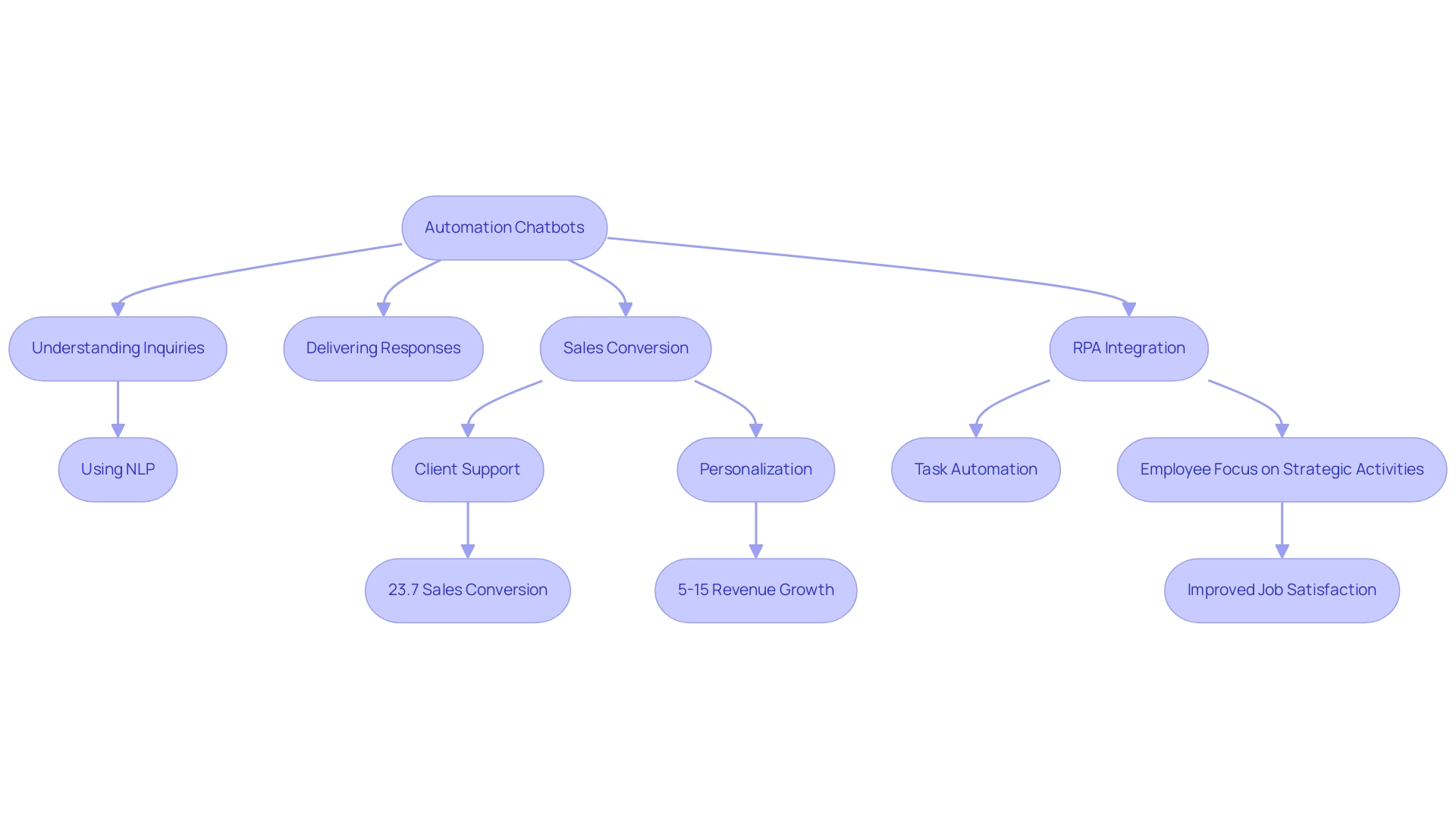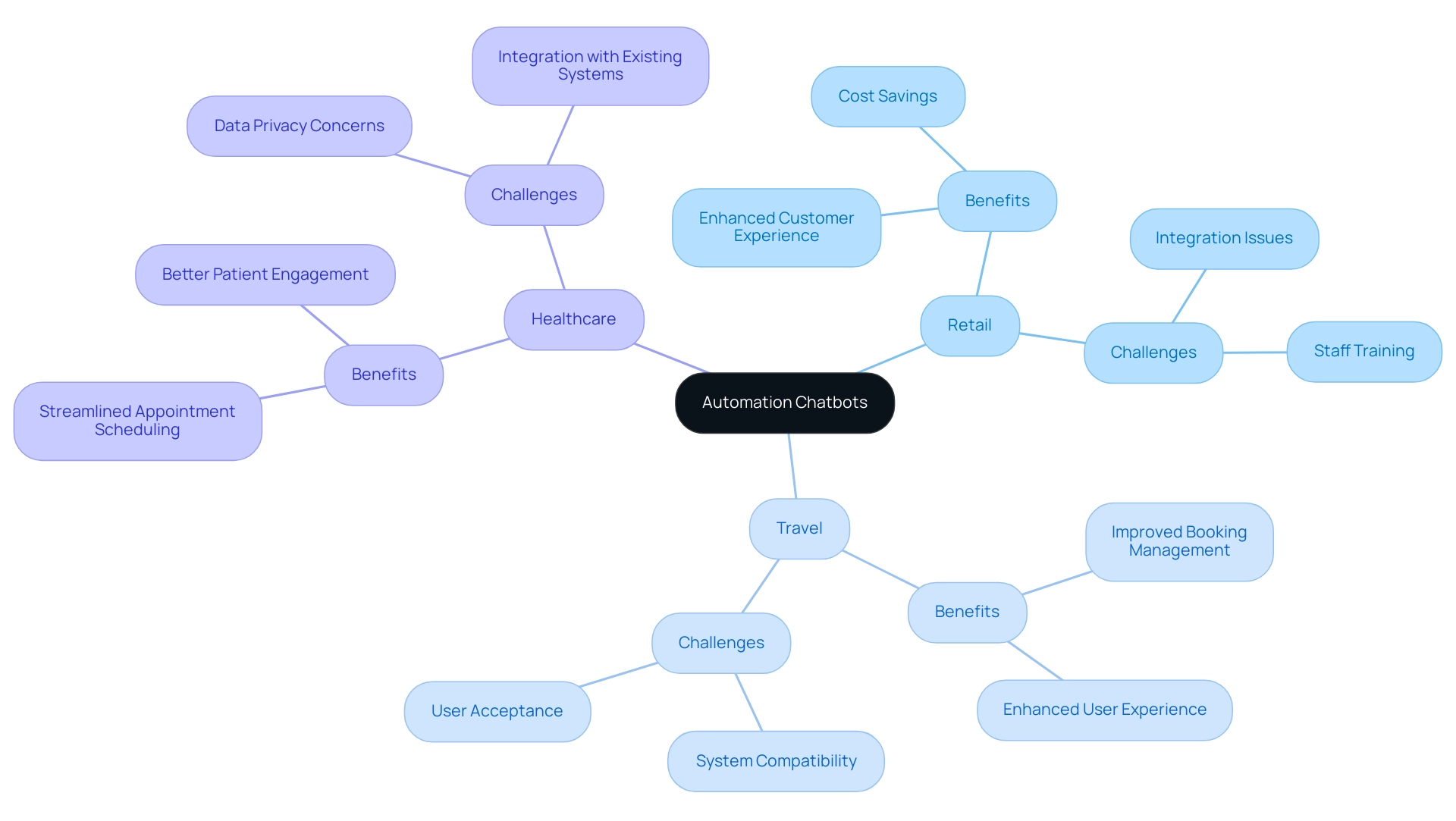Introduction
In an era where customer expectations are higher than ever, automation chatbots are emerging as a game-changer for businesses striving to enhance operational efficiency and user engagement. These intelligent systems, powered by advanced artificial intelligence and natural language processing, are not just tools for answering inquiries; they represent a strategic shift in how organizations interact with their customers.
From streamlining customer service to driving sales conversions without human intervention, the capabilities of chatbots are reshaping industries across the board. As companies increasingly adopt these technologies, understanding their functionality and real-world applications becomes crucial for leveraging their full potential.
This exploration delves into the transformative benefits of automation chatbots, their operational foundations, and the innovative trends that are set to redefine customer interactions in the near future.
Defining Automation Chatbots: What They Are and How They Work
Automation virtual assistants represent advanced software applications designed to simulate conversation through the power of artificial intelligence. By utilizing predefined scripts and advanced algorithms, these virtual assistants are adept at understanding user inquiries and delivering appropriate responses. Central to their functionality is natural language processing (NLP), which enables them to interpret and process user inputs in real-time, facilitating immediate assistance.
This ability is especially beneficial in client support, as data shows that 23.7% of inquiries can convert into sales without personal involvement. Moreover, recent studies highlight that personalization through digital assistants can drive revenue growth for telecom companies by 5% to 15%. A significant case study named ‘Chatbots for Upselling’ demonstrates how automated assistants can effectively suggest additional products based on customer preferences, with 20% of companies utilizing this method to boost sales.
As Kateryna Cherniak, an SEO Specialist, notes, ‘Globally, 38% of consumers hold a positive view of digital assistants.’ Meanwhile, integrating Robotic Process Automation (RPA) solutions like EMMA RPA and Microsoft Power Automate can further enhance operational efficiency and employee morale. RPA specifically addresses task repetition fatigue by automating mundane tasks, allowing employees to focus on more strategic activities, thus improving job satisfaction.
The friendly robots depicted in the illustration, standing alongside a human figure, symbolize the collaboration between humans and machines in the workplace, emphasizing the seamless integration of RPA in enhancing service delivery. As more companies adopt automation chatbots and RPA, the role of these technologies in improving user interaction and generating data-driven insights becomes more apparent, enabling organizations to maneuver through the swiftly changing AI environment.

The Benefits of Automation Chatbots in Modern Business
The adoption of automation chatbots presents a transformative opportunity for modern businesses, particularly in enhancing operational efficiency through Robotic Process Automation (RPA). One of the most compelling advantages is cost reduction; an automation chatbot can efficiently manage multiple inquiries simultaneously, significantly cutting the need for additional staffing. This capability not only reduces operational costs but also enhances service, ensuring instant responses that drive improved satisfaction and engagement.
Notably, lead qualification through chatbot quizzes yields results that are 20% superior to traditional static forms. As Nicolas Babin, a Key Opinion Leader, states, today’s clients expect a mix of self-service and human assistance, which an automation chatbot can successfully provide based on the complexity of inquiries. MarketWatch states that 80% of clients believe businesses lack context in prior interactions, emphasizing the necessity for virtual assistants to adjust to client needs.
Businesses such as Sephora and H&M illustrate this trend, efficiently utilizing virtual assistants for product inquiries and order tracking, leading to increased sales and client loyalty. Moreover, a telecom company utilizing an automation chatbot for Messenger reported a remarkable 3.5-fold increase in employee productivity and a 50% reduction in hotline calls. These success stories highlight how virtual assistants streamline operational processes by automating repetitive tasks, empowering human employees to focus on strategic initiatives, and ultimately driving profitability and client satisfaction.
Importantly, successful deployment of the automation chatbot hinges on proper implementation and continuous improvement based on customer feedback, ensuring that the automation chatbot evolves to meet changing customer expectations. Additionally, leveraging business intelligence can transform data into actionable insights, aiding informed decision-making in chatbot deployment and optimization, ultimately enhancing user interaction and operational efficiency.

Technological Foundations: How Automation Chatbots Operate
Automation systems, such as automation chatbots, are revolutionizing user interaction through foundational technologies like natural language processing (NLP) and machine learning (ML) algorithms. NLP allows virtual assistants to understand and interpret language, facilitating meaningful and contextually relevant conversations. This capability is further enhanced by machine learning, empowering conversational agents to learn from prior interactions and refine their responses over time.
Notably, 23.7% of inquiries now convert into sales without any human intervention, showcasing the effectiveness of these systems. In a rapidly evolving AI landscape, the NLP market experienced a remarkable growth rate of 36.5% in 2022, reflecting a shift towards sustained development as the technology matures. Numerous virtual assistants utilize cloud-based platforms for data storage and processing, ensuring scalability and flexibility in operations.
As 56% of companies recognize automation chatbots as industry disruptors and 57% acknowledge their substantial ROI with minimal effort requirements, understanding the operational foundations of these automation chatbot technologies is crucial for effective implementation and optimization. Furthermore, Robotic Process Automation (RPA) plays a vital role in this ecosystem by reducing errors and freeing up team resources, allowing organizations to focus on strategic initiatives. Additionally, leveraging Business Intelligence can transform raw data into actionable insights, enhancing decision-making processes.
As we look towards 2024, advancements in machine learning and AI are expected to further enhance the human-like qualities of automation chatbots, making them indispensable tools for businesses aiming to streamline workflows, enhance productivity, and make informed decisions.

Real-World Applications: How Businesses Use Automation Chatbots
The adoption of automation chatbots is rapidly transforming client interactions across multiple sectors, demonstrating their remarkable versatility and effectiveness. In the retail landscape, brands like Domino’s Pizza have harnessed automation chatbot technology to streamline order placements and monitor deliveries, significantly enhancing customer convenience. The travel sector is also experiencing this transformation; companies like Expedia utilize an automation chatbot to manage booking inquiries and assist with travel arrangements, thereby enhancing user experiences.
Moreover, in healthcare, providers are adopting an automation chatbot as part of their automated messaging systems to facilitate appointment scheduling and handle patient inquiries, which not only streamlines administrative tasks but also fosters better patient engagement. Significantly, 23.7% of inquiries turn into sales without human involvement, emphasizing the efficiency of automated systems in driving sales. As stated by Daria Ritter, a marketer at Dashly.io, over 50% of clients appreciate engaging with AI conversational agents, highlighting their acceptance among users.
Key to this transformation is the integration of Robotic Process Automation (RPA), which automates manual workflows, leading to enhanced operational efficiency and productivity. Businesses save an impressive average of $300,000 annually through the implementation of automation chatbots, as highlighted in case studies, demonstrating the significant cost reductions associated with these technologies. However, organizations often face challenges in implementing these solutions, such as integration with existing systems and staff training.
Tailored AI solutions can help navigate these challenges effectively. These practical applications illustrate how automation programs, driven by RPA and Business Intelligence, are not only improving operational workflows but also transforming the way enterprises interact with their clients, facilitating informed decision-making that is simpler and more efficient.

The Future of Automation Chatbots: Trends and Innovations
The landscape of automation systems is on the brink of remarkable evolution, fueled by continuous advancements in artificial intelligence and machine learning. Currently, about 60% of B2B companies and 42% of B2C businesses are harnessing automation chatbot software, signaling a significant trend toward automation in customer interactions despite common apprehensions regarding:
- Complexity
- Implementation costs
- Perceptions that AI projects are time-intensive and challenging to integrate
Innovations in natural language processing (NLP) are set to enhance these capabilities, enabling conversational agents to grasp context and sentiment, which leads to more personalized user experiences.
Furthermore, the growing prominence of voice-activated chatbots is revolutionizing how users engage with technology, facilitating hands-free communication. According to recent findings:
- 90% of businesses have reported quicker complaint resolutions thanks to automation chatbot integration.
- 83% of consumers indicated they would prefer messaging as their primary method for customer support if they could expect immediate responses, showcasing the importance of effective automation chatbot functionality.
Notably, 61% of people would find it more frustrating if a chatbot couldn’t solve a problem compared to a human. As companies work to improve operational efficiency and address data quality issues, the growth of automation systems seems unavoidable. The effective implementation of an automation chatbot, as highlighted in a recent case study, emphasizes the need for clear objectives and user-friendly designs to enhance customer interactions.
By leveraging tailored AI solutions and Robotic Process Automation (RPA), businesses can streamline manual workflows and make informed decisions that drive growth. With emerging trends paving the way for more sophisticated solutions, the future of automation chatbot technology in 2024 promises to redefine user interactions and elevate service excellence.

Conclusion
The rise of automation chatbots marks a pivotal moment for businesses aiming to enhance operational efficiency and customer engagement. By leveraging advanced technologies like natural language processing and machine learning, these intelligent systems are transforming how organizations interact with consumers. From improving customer service response times to driving sales conversions, the benefits of chatbots are extensive and far-reaching.
As explored in various sectors—from retail to healthcare—automation chatbots not only streamline processes but also significantly reduce operational costs. Companies are witnessing enhanced productivity and customer satisfaction, thanks to chatbots’ ability to handle multiple inquiries simultaneously and provide personalized experiences. The integration of Robotic Process Automation further amplifies these advantages, allowing human employees to focus on strategic initiatives and improve job satisfaction.
Looking ahead, the future of automation chatbots is bright, with innovations in AI and voice technology poised to redefine user interactions. As businesses continue to embrace these advancements, the potential for improved service delivery and operational efficiency becomes increasingly evident. By understanding and implementing these technologies effectively, organizations can position themselves at the forefront of customer engagement, ensuring they meet the evolving expectations of today’s consumers. Embracing automation chatbots is not just a technological upgrade; it is a strategic imperative for businesses committed to thriving in an increasingly competitive landscape.

